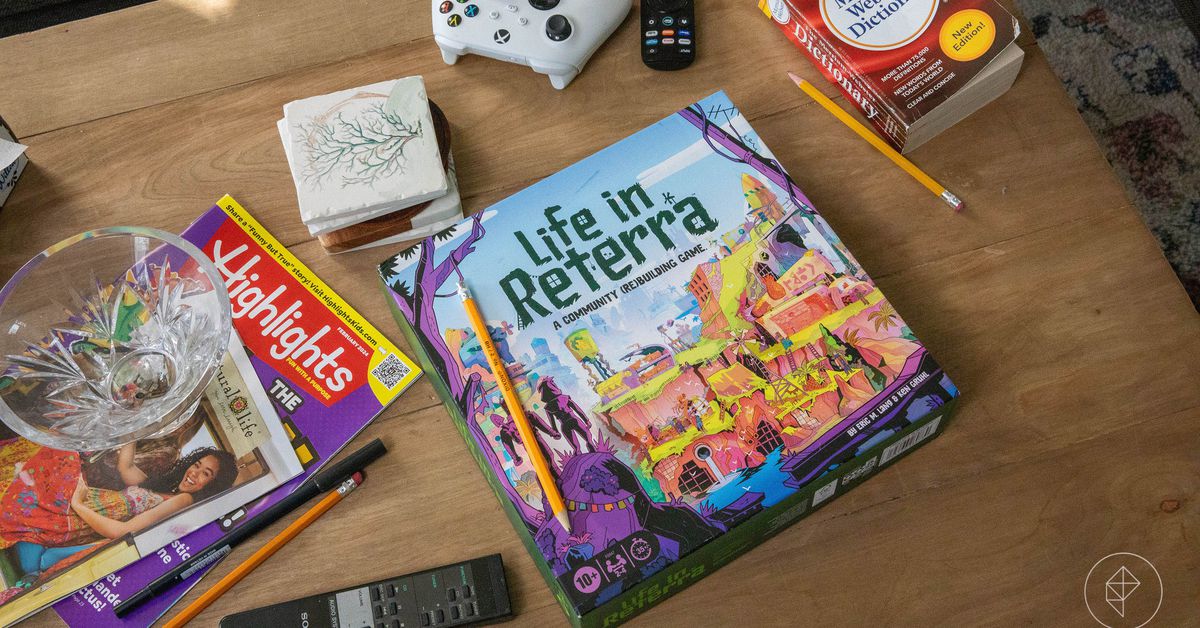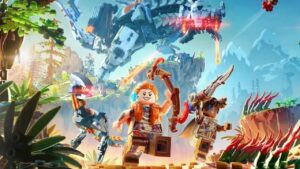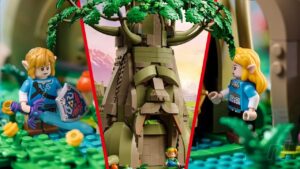A good board game has many layers. Narrative layers surround and define the plot of the board game, while mechanical layers manage the moment-to-moment action. More complex games have a rich strategic layer, with players trying to outsmart each other in multiple moves or games. There’s also always a social layer, which can be as simple as getting people together to play or as nuanced as the communication and negotiation skills needed to excel in Catan. But Life in Retera, a new board game designed by Eric M. Lang and Ken Gruhl with art by Hugo Cuellar, has a layer that many other games don’t have – a creative layer. This makes it one of the most interesting new titles of the year.
Life in Retera posits a distant future where urban centers have been reclaimed by nature and where notions of humanity’s past exist only as artifacts. It is up to the players to rebuild these cities as they see fit. The art style reflects this conceit well, with brightly colored tiles filled with different biomes, as well as the occasional relic like a smartphone. Players earn points for organizing these biomes into contiguous sections, filling the table in front of them with green spaces, deserts, and cheerful lakes or streams.
But the land itself is only the first layer of the game. As players place these tiles, they must constantly consider their orientation to create the largest and most valuable biomes they can, but also to create the foundations needed to place specially shaped buildings on top. And it is in the placement of these buildings that the game begins to show its true potential.
The buildings in Life in Retera are organized into three different sets, each more complex than the last. In the “starter set” of the game, gardens are worth extra points, but only if you have the largest segment of contiguous terrain on the table. Schools are worth extra points for each different type of relic you have on the board, etc. There are three sets in total, representing a total of 30 different buildings in the box.
In addition to the starter kit, the manual for Life in Retera includes only four more “select construction sets”. The Unfriendly Neighbors set is confrontational, with players using buildings in ways that dramatically affect other players at the table. The peace and quiet set has very little interaction between players. Meanwhile, the popularity contest set sits somewhere in the middle. In this way, the mechanical layer of the game can be changed at will. Once you get far enough into the guide, Life in Retera becomes something of a platform, a system capable of being different games for different audiences at different times.
And then, on page 14 of the manual, Life in Retera does something remarkable: it asks players to prepare their own sets of buildings to play with. “My Construction Kits,” reads the two-page spread, revealing a blank worksheet with room for four new ways to play that players can create themselves.
With this last creative layer, Life in Retera invites players to become designers themselves. The guide, no matter how expertly written, fades into the background to become simply a starting point. The rules are there to facilitate the game, not to dictate what the nature of that game should be. In the end, it’s up to the people to have fun themselves, remodeling the game to suit their needs, even as they rebuild the land itself. It’s a bold move — especially for a game aimed at mass-market retailers.
At the same time that Lang, Gruhl and publisher Hasbro brought their layered, open design to the toy aisles at Target, they also chose to bring some of the boutique design and finish to high-end board games. Life in Retera not just a cheap box of cardboard bits and plastic blanks. The cards are solid with a nice linen finish, the wooden maples are screen printed, elegantly hand stitched and all components are stored in modular plastic trays with clear lids. Opening it up, this game looks and feels like something you’d get in the mail after a successful Kickstarter campaign.
When I interviewed Lang earlier this year, he called Life in Retera “lifestyle game”. At the time, I thought it meant a game that would welcome newcomers to the larger board gaming hobby and encourage them to make board gaming a part of their lives. But rather the opposite is true. Life in Retera is an incredibly solid and durable design that, as a collectible card game, can be mixed and remixed into many different experiences. It’s also a game that respects the player’s time, and a physical product that’s built to last. For that reason alone, it found a permanent place in our home—not in the closet or on a shelf, but right in the middle of the coffee table.
Now, mixed in with all the other pressing waste of our modern lives—remote controls and smartphones, chewed-up pencils, junk mail, and unfinished homework—is our family’s new favorite board game. Life in Retera it’s become something we come back to every week, and even when we’re not playing, sometimes we’re just daydreaming about the builds we might come up with for the next go-around.
Life in Retera it didn’t change our family’s lifestyle, but it made its way into it. I think it could easily find a place in your home as well.



